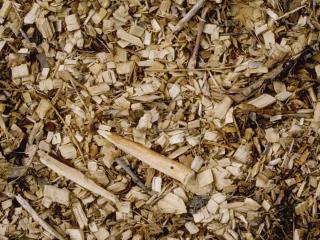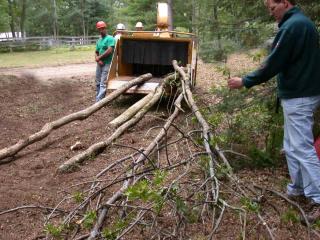

Ramial Chipped Wood, or RCW for short, is a type of mulch that maximizes forestry waste. When trees are harvested for wood, their branches and twigs can become nutrient-rich mulch for gardens and vegetable beds.
RCW is also called BRF, from the French Canadian researchers who developed the technique: Bois Raméal Fragmenté.
In this article, we’ll share about the advantages of RCW and which tree species it’s best to source it from.
→ Read also:
Plots of land where conifers have been growing for a long time tend to turn acidic. Conversely, soil that is above limestone bedrock tends to be rather alkaline.
 Ramial Chipped Wood corrects these deviations and brings soil pH nearer to neutral.
Ramial Chipped Wood corrects these deviations and brings soil pH nearer to neutral.
Applying RCW over a couple seasons will significantly impact the pH.
This is very relevant in tropical island countries, where most of the soil is alkaline due to pH-raising coral bedrock.
Ramial chipped wood has the capacity to enhance and increase the quality of all types of soil. This is due to long, woody compounds called lignins and cellulose that take up to several centuries before breaking down entirely.
In a way, it’s the ultimate natural slow-release fertilizer!
→ More natural fertilizers for the garden and veggie patch
 Overall, hardwood deciduous trees make for the best Ramial Chipped Wood material. Their tips are replete with nutrients all year long:
Overall, hardwood deciduous trees make for the best Ramial Chipped Wood material. Their tips are replete with nutrients all year long:
Ramial chipped wood is a great way to maximize forestry revenue. Just as a wheat farmer sets stalks aside as straw fodder for animals, tips of trees are also a potential resource.
Thinning rows of cultivated trees, a practice that maximizes growth of the most promising specimens, results in a lot of extra material. Wood is either sold or kept for firewood, but until recently, leafy fronds were simply left behind.
With ramial chipped wood mulching, this rich material can benefit fields in a completely organic and environment-friendly way.
Deciduous trees such as birch, poplar, maple and hophornbeam are often used for RCW. They are fast-growing. When harvested at mature size, these trees can earn an extra amount from the very rich branch tips they leave behind.
Upon harvest, noble woods such as oak, beech and in recent times locust and walnut are also a great source.
In a garden, many ornamental tree trimmings are suitable for recycling into RCW.
Evergreens that aren’t conifers also make excellent ramial chipped wood, even up to 100%.
Lastly, recycle trimmings from the yearly fruit tree pruning in the orchard.
To avoid spreading diseases, don’t include diseased branches. If you do, don’t use the resulting mulch under the same type of tree.
Don’t discriminate when clearing a lot. Simply add it all in.
However, mulch made exclusively from these isn’t as nutritious as that of tree-based ramial wood chips. Since not made from tree branches, the name Ramial Chipped Wood isn’t appropriate anymore.
A few trees (and plants) exhibit strong allelopathic properties. It’s the accurate term to say “it kills its peers”. Known examples are eucalyptus, walnut and mahogany: these exude compounds that prohibit germination and stunt growth of other plants and trees. In a way, the acidic soil under conifers is also a form of allelopathy.
As such, conifers, eucalyptus and pine trees are acceptable but only in a small proportion, under 1/10th. Indeed, they would tend to acidify soil or render it less suitable for growing compared to more “generous” deciduous tree ramial wood chips.
→ Read also: What is BRF mulch?